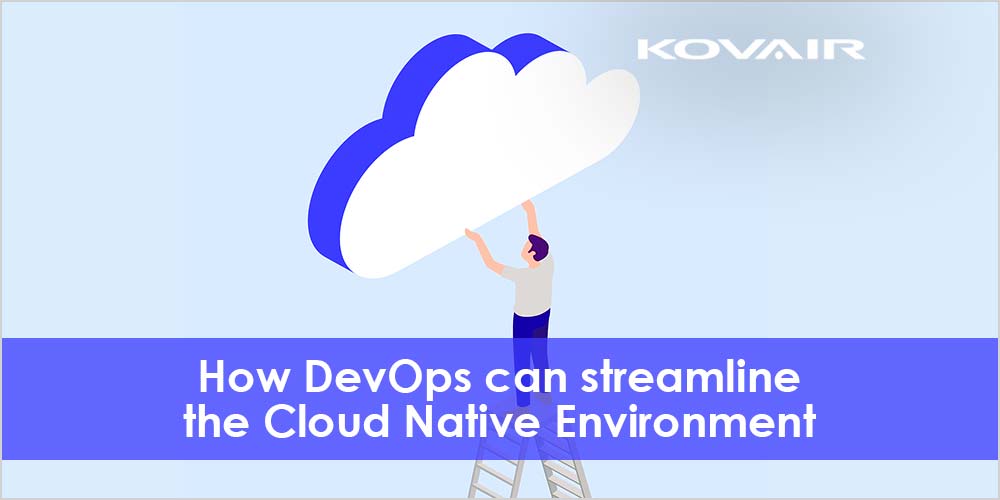DevOps can streamline the Cloud Native Environment – Read How?
Blog: NASSCOM Official Blog
According to Gartner, “Technology product management leaders must deliver cloud-native offerings now to capture business opportunities and avoid irrelevancy.”
The role of DevOps is getting traction more than ever as the world is going cloud-native. DevOps plays a significant role in helping organizations embrace cloud-native approaches. It aims to inject automation between development and operations teams to boost collaboration. The goal of DevOps strategies is to improve the development cycle, minimize deployment failures, streamline communication, increase effectiveness and more. DevOps practices and methodologies lay down the foundation for effectively executing cloud-native approaches.
Cloud-native is a way to foster innovation to transform enterprises and DevOps aligns people, processes, practices and technologies to enhance the organization’s efficiency. DevOps creates an environment of collaboration, transparent processes, modular programming with which organizations can experience a drastic reduction in latency and glitches. Cloud-native development services are gaining momentum as framing a successful cloud strategy depends on how well businesses embrace Agile methodologies and DevOps environments. This blog will explore the indispensable role of DevOps and cloud-native application development strategies to propel business growth.
Here is what you need to know about how Cloud Native complements DevOps
IT Transformation – Cloud native technologies empower organizations in transforming their IT to develop applications for public, private and hybrid cloud environments. DevOps on the other hand helps the teams in problem-solving, and continuous delivery while helping them cope with the cloud-native shift. DevOps culture drives a CI/CD paradigm with improved deployment time, better lead times, faster recoveries as teams can simultaneously iterate on software in parallel. DevOps facilitates the deployment of cloud-native technologies like containerization and microservice architectures along with enhancing team efficiency.
Innovative Business Environment – The success of cloud-native application development strategies depends on innovation and continuous improvement. Organizations that execute DevOps can quickly innovate and get into the action by developing in application features without any lag. Corporates can robustly incorporate customer feedback, take their queries into consideration and release updates faster to improve customer experience. DevOps enables the implementation of cloud-native strategies to make Cloud-native applications fault-tolerant. DevOps mechanisms help organizations to manage cloud-native applications to meet customer requirements by providing a competitive advantage in the market.
Role of Containers and Microservices Architecture – Containerization modernizes the legacy systems to develop powerful cloud-native apps, reduces the cost of infrastructure operations, and makes deployment easier and faster. As it allows applications to develop in an environment-agnostic manner, containers eliminate the application conflicts between teams and high collaboration. Microservices architecture helps an organization embark on the journey of agile software development. Moving from monolithic applications to microservices simplifies the tech stack, manages the distributed teams, improves the speed by decomposing, enhances productivity and more.
Agile-infused Practices– Cloud-native applications can be managed with a CI/CD pipeline to ensure an agile development process. DevOps practices create a culture of continuous delivery to enable cloud-native application development. DevOps gives rise to an Agile environment in which the entire development process takes place in an ongoing cycle in a fast-paced and continuous ecosystem. Business-critical applications are dependent on containerization and microservices and require a resilient approach to software development and delivery to overcome glitches and losses. DevOps induces scalability, transparency and flexibility with faster implementation to ensure agility. The agile environment is the prerequisite for moving from monolithic to cloud-native environments.ma
Organizational Benefits – Businesses building Cloud-native applications adopt DevOps to achieve faster time-to-market, reduce the number of defects, reduce the number of defects, minimize the cost, enhance the collaboration, improve the frequency of updates, and enhance the application’s performance. DevOps focuses on continuous development, delivery and integration that creates a ground for automation which automates repetitive tasks, curtails manual errors and minimizes the operational costs. Business performance curve witnesses an upward rise when Cloud Native and DevOps have planned and executed well that creates synergy.
Conclusion
CEOs that are looking forward to delivering modern applications in an Agile environment need to shift from monolithic architecture and move away from legacy processes to realize the business goals. Cloud-native application development increases the release pace, delivers superior customer experiences, eases the management, reduces cost through containerization & cloud standards, builds more reliable systems and avoids the situations of vendor lock-in. Cloud-native technologies like microservices and containers are based on DevOps principles like CI/CD.
Leveraging DevOps methodology ensures continuous updates keeping the latency low. Businesses that are embracing a cloud-native approach is way ahead of their competition enabling better scalability, transparency and flexibility in the operational workflow. DevOps focuses on maintaining the friction in cloud-native application workflows. When planned and executed well, your business can witness faster software releases with improved application performance and better user experience. Cloud-native and DevOps are a perfect mix for organizations aspiring to digital transformation journey.
Source: How DevOps can streamline the Cloud Native Environment
The post DevOps can streamline the Cloud Native Environment – Read How? appeared first on NASSCOM Community |The Official Community of Indian IT Industry.
Leave a Comment
You must be logged in to post a comment.









